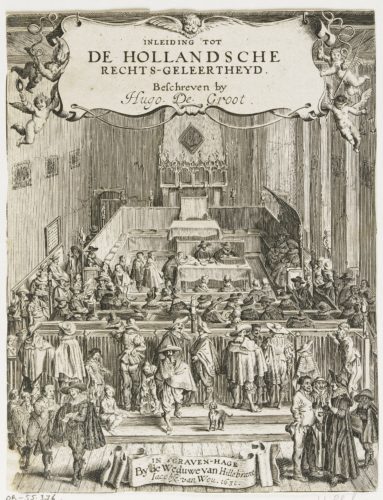This populous, male, formal court-room scene represents a completely different kind of space from the village green where unfortunate women were tried by archaic means. This is the title-page of the great 17th-century Dutch jurist Hugo Grotius’ authoritative compendium, Introduction to Dutch Jurisprudence (written from 1619 to 1621). The engraving is an allegorical depiction of the interior of a recognisably seventeenth-century courtroom in Netherlands, in full sessions. At the top, a scroll with the title is held by angels, with the attributes of prudence, equity and justice: a mirror, balancing scales and a sword. But the allegorical framing contains an image of law as social action, discourse and commerce, as well of law as institutional procedure.
The space of this courtroom itself shows an enclosure, where the public is set in the foreground, a reminder that court sessions were open to the public. Nobles and rich merchants exchange information and trade legal scandals in huddles. A dog wanders and two young boys play, as the edges of legal space shade off into spaces of recreation. Further back, in the centre, more serious legal business is conducted, judges and law-clerks pore over paperwork, and the audience includes both men and women, some of them perhaps waiting to be called upon as witnesses. The space of the ‘parquet’ where litigation occurs is shown as a lively hearing where benches are crowded, with legal officials seated at the heart of the court. Two judges are sitting on their benches on the right, identifiable by their typical square hats. What is striking is that the group of magistrates seems to play a less conspicuous role in the drama of this court than the merchants in the foreground. The bustle and variety of the scene seems to reflect Grotius’ secularisation of natural law, connecting it with human reason, without eschewing the theological superstructure.











